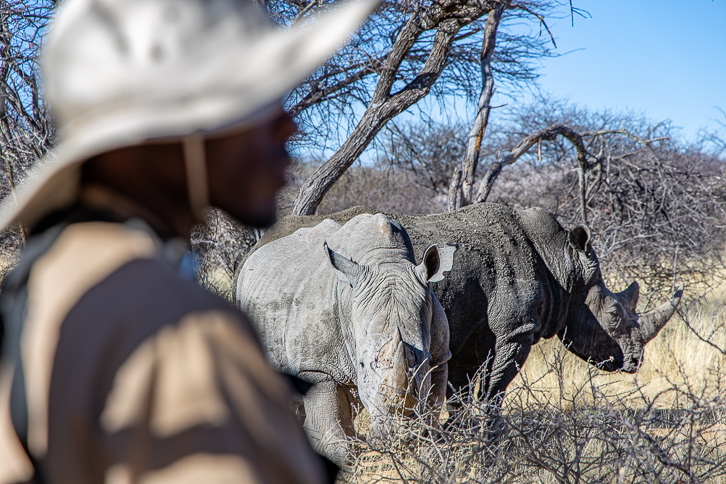You wouldn’t know it from their ferocious appearance, but rhinos are actually quite shy. They scamper away when you approach them in a rattling safari jeep.
If we want to see them up close, we have no choice but to stalk them on foot. No kidding?!
The preferred way to do a safari in the African bush is in an open safari jeep. In Namibia, this typically means you’ll be riding in a large Toyota Land Cruiser with a sun canopy.
The theory is that the animals see the vehicles as a big unit that poses no threat to them. Hence, tourists can feel reasonably safe in them.
So…rule number one: Never get out of the jeep if you don’t want to get eaten or trampled to death.
However, elephants on occasion will take on one of the rumbling metal four-wheelers: for one close call, read about my panic moment on another safari in the Ongava Nature Reserve.
However, today Katja and I are out to see another giant up close: the rhinoceros.
Tracking down the white rhino – on foot!
Our guide Pascalis teaches us the difference between black rhinos and white rhinos: Actually, both species are gray all over, but the black rhinos are aggressive and super dangerous and should never be approached. Especially when on foot!
White rhinos are a bit more approachable, but are not for petting either! The problem is that rhinos do not see well: Startle them and you’re asking for trouble.
An experienced guide, Pascalis knows where to find these less frisky white rhinos. The black rhinos we will avoid at all costs for the stated reasons!
After a short drive, Pascalis turns off the engine in the middle of the bush and with his binoculars scans the empty steppe for what feels like five minutes. He first wants to assess the situation well before we venture out of the safari jeep.
A hungry lion or leopard waiting in ambush would evidently be awkward for us at this point.
Before we climb down from the vehicle, Pascalis explains to us exactly how we should act. Running away is not an option under any circumstances!
The coast seems to be clear. The wind also blows from the right direction: rhinos don’t see well, but they have excellent smell and hearing. We will stalk the rhinos, which are now coming into view some distance away, into a headwind.
As a final precaution, Pascalis loads his rifle. He assures us, however, that in all his years as a guide he has never had to use it. And if he had, it would only have been to crank off a few warning shots.
How reassuring…
#not!
With a sinking feeling and wobbly knees, we slowly close with the peacefully grazing rhinos.
We halt behind a bush. We hold our breath as several of the giant beasts turn toward us.
In the end, my telephoto lens bests their little eyes, so that – hugely impressed – we eventually make our way back to the jeep undisturbed.
Closer and closer, and still, they don’t see us…
During a second rhino stalk – on foot naturally! – we get even closer to the giants, as they neither see us behind some trees nor smell us because once again the headwind hides us from them.
As they keep grazing, they slowly come towards us until we barely dare to breathe.
When they are only a few meters in front of us, we even have to back up behind other trees to leave enough space between us and them and keep things from getting dicey.
That’s probably as close as we should ever get, intentionally or otherwise. My heart rate won’t go any higher either…
Note the down jacket on top of the fleece…
Incredibly, these huge creatures were almost wiped out by the early 20th century. Apart from drought, poaching is the biggest threat to the rhinoceros.
They are hunted down for their horn, which is made of keratin. In Chinese culture, the horn is traditionally valued as a cure for impotence and therefore fetches high prices on the black market.
Tourists in the area where the rhinos roam are asked among others precautions not to publish Instagram or Facebook posts with location details of their rhino encounters.
For this reason, I won’t detail here exactly where we stalked our rhinos. However, if you are interested, I will gladly pass on which lodge has rhino safaris in its program.
